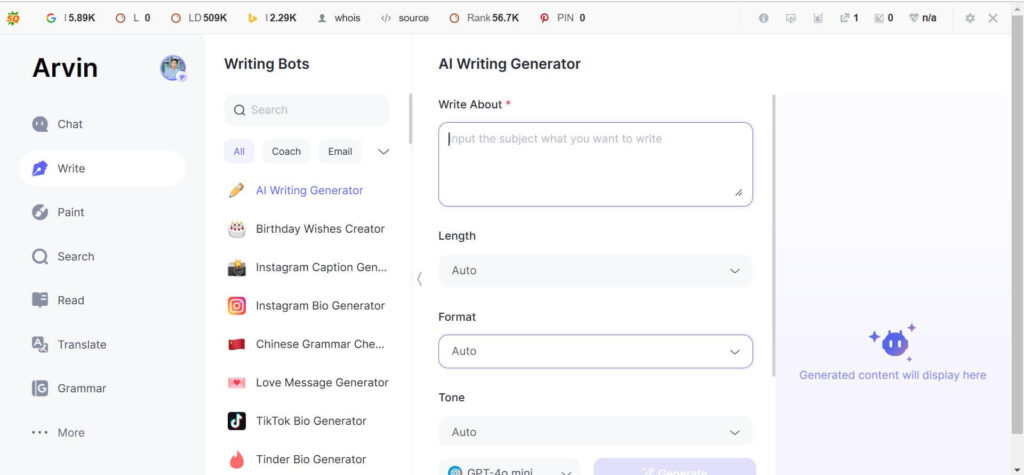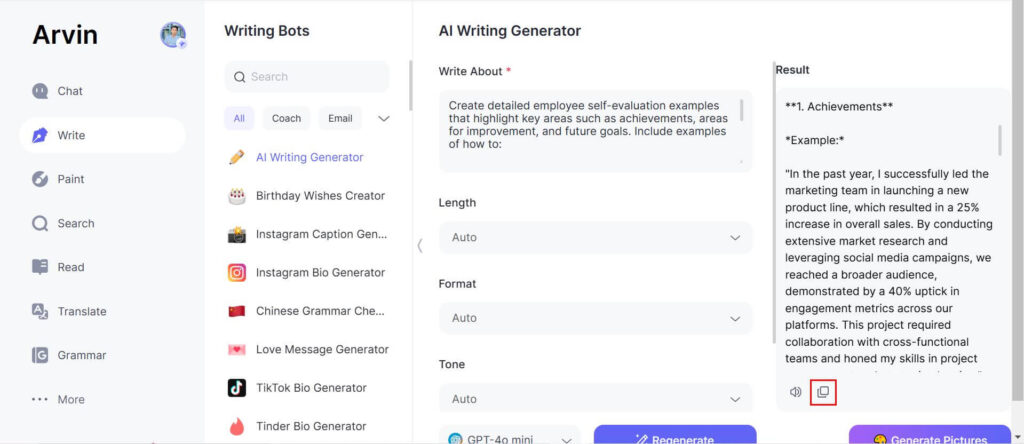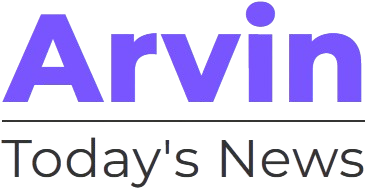Employee self-evaluation can also be highly valued as one of the basics of today’s working environment. It assists them to review their achievements, work output and inerrable improvement zones. This fosters accountability and reliability from the employees and managers as well as improves clarity. Besides, transparency, employee self-evaluation examples make an individual to be more complied in his or her developmental processes in the work place thus making the workforce to be more active. With AI writing tools like Arvin AI, this step has become much easier and faster because AI presents many templates for creating this self-evaluation while the core ideas are distilled and presented as easily understandable data points.
Part 1: The Purpose of Employee Self-Evaluations
Autonomy is the foundation for self-organization and accountability in a work setting… Evaluating personal performance results will make an employee learn strengths and weaknesses hence realize organizational contributions. This is one of the practice of self-reflection that would promote openness in organizations. It makes lot of difference as employee get more comfortable in sharing their experiences and other matters with their manager. Additionally, self-assessments co-ordinate the business and staff objectives; this boosts an employee self-evaluation examples advancements and management planning processes.
Benefits of Effective Employee Self Evaluation Examples
Other possible upsides that were only implied are; Self-evaluations improve trust in the organization. Worker’ possession of performance is also considered a plus on employees as they build stronger working relations with their managers. This makes it easy for there to be more dialogue which can bring about higher levels of involvement of the employees.
Better performance increases productivity and motivation, which inculcate positive attitude in several individuals in the workplace. Performance appraisals are also made valid by self-appraisals. It gives a clear picture that enhances the feedback of the managerial team. Integration of these ideas is helpful to guarantee that reviews are also balanced to support the need for individual and organizational growth.
Challenges in Writing Self-Evaluations
Writing a good self-appraisal can be difficult. One of the common problems is finding the appropriate balance between humility and confidence. Employees will dread appearing proud in drawing attention to achievements or, on the other hand, humble to the point of trivializing contributions. A related challenge is the potential for ambiguity or overstatement. An effective self-appraisal needs to be specific and to the point, focusing on specific instances and measurable results rather than broad statements. Lastly, most employee self evaluation examples fear criticism or devaluation and may resist expressing candid areas of needed development or unmet objectives.
Part 2: Examples of Employee Self-Evaluations
Examples by Role
What goes into a self-evaluation differs depending on the role of the employee self evaluation examples. For instance, managers are more likely to reflect on the accomplishments of their leadership skills, team development, and strategic decisions. An example self-evaluation could be as follows: “I led a team of 15 people to complete quarterly goals successfully, hence upping productivity by 20% over the preceding quarter.”
Entry-level employee self-evaluation examples might use flexibility, learning, and contributions to small projects as strengths. A self-assessment might be: “In my first year, I learned three new software tools and contributed to a major project that improved process efficiency by 15%.” Team leaders would highlight coordination and conflict resolution and may use such examples as: “I led weekly meetings to synchronize the team’s goals; two major workflow conflicts were resolved and delivery timelines improved.”
Examples by Industry
Information technology and software development specialists will discuss technical skills, innovation, and teamwork. It would be, “I came up with a new feature for our app that improved engagement by 30%.”
Customer care representatives could speak about clients’ satisfactions and how they relate through communication skills and say, “I had 95% satisfactions and also reduced responses by 10% for the last six months.”
Self-evaluations in marketing and sales might focus on the successes of a campaign or revenue increase. An example would be, “I led a digital campaign that brought about a 25% lead increase, resulting in an additional $200,000 in revenue.” Educators and academic staff might focus on teaching strategies, student outcomes, or curriculum improvements, such as, “I introduced a new teaching approach that resulted in an improvement of 15% in student test scores.”
Examples Based on Performance Metrics
Self-assessments usually highlight specific performance measures. Staff can also point out major achievements, including meeting or beating set targets as well as milestones like significant project completions. For instance, “I exceeded my sales goal by 18%. It made it a record-breaking quarter for the team.” But improvement areas must also be addressed. A truthful review could be, “Although I was able to complete most tasks on time, I have come to realize that I should work on the management of time to effectively undertake several tasks. “Actionable goals: “I intend to increase my technical competencies by finishing an advanced course in data analysis by the end of the quarter.”
Templates for Employee Self-Evaluation
Employee self-evaluation templates are available to make the process more efficient. A template of standard format could have sections consisting of strengths, weaknesses, achievements, and futures. For instance, in terms of strengths, the employee self evaluation examples could outline “strong interpersonal skills.” Then, he/she may put an example like “successfully mediated team conflict that restored collaboration.” And weaknesses can be said positively: I need to improve public speaking skills, which I want to do by attending a certain workshop. Contributions would reflect with measurable results, while goals have professional development and long term.
Part 3: How to Write a Powerful Self-Evaluation
Reflection on Past Achievements and Failures
Begin by honestly reflecting on your past successes and challenges. Major milestones concerning the role highlight how well they contributed to success in the team or organization at large. Equally important, areas where failure was experienced need to be admitted as part of growth; explain how these experiences have influenced your professional growth. For instance, one may give an example of how failing a project taught better time management or collaboration techniques.
Clear and Measurable Goals for the Future
A powerful self-evaluation is forward-thinking. Outline your professional aspirations in specific, measurable terms. For example, instead of stating, “I want to improve my skills,” say, “I aim to complete advanced certification in project management within the next six months to enhance my ability to lead complex projects.” This demonstrates a proactive approach to personal development and aligns your goals with organizational objectives.
Supporting Examples and Data
Quantify your assertions with evidence. Use the numbers, for example, in meeting the sales targets or efficiency improvement by a certain percentage, to emphasize what you have brought to the table. Similarly, qualitative examples, like a successful team project that you led or positive feedback from clients, can help bring out your impact. Giving real-life examples lends credibility and depicts your worth to the organization.
Do’s and Don’ts
Do: Be honest, use specific examples, and focus on growth
- Be honest: Authenticity breeds trust. Show your strengths and weaknesses.
- Use examples: Details make your review interesting. Instead of saying, “I increased team efficiency,” say, “Through the implementation of a workflow that streamlined our work; we were able to complete projects 15% faster.”
- Focus on growth: Share how you have grown and what you will work on to improve.
Don’t: Be Overly Critical, Overly Boastful, or Vague
- Don’t be overly critical: While acknowledging areas of improvement is vital, avoid self-deprecating language. Instead, frame challenges as learning experiences.
- Don’t be overly boastful: Balance confidence with humility to avoid sounding arrogant.
- Don’t be vague: General statements dilute the impact of your evaluation. Replace “I contributed to team projects” with “I led a cross-functional team to complete a project ahead of schedule.”
Tips for Writing a Balanced and Impactful Self-Evaluation
Use Action-Oriented Language
Use action verbs such as “initiated,” “accomplished,” “streamlined,” or “collaborated.” It’s a decisive and positive way to relate that you have been pro-active about the responsibility.
Focus on Contributions to Team and Organizational Goals
Relate to higher-order objectives by showing that what you do helps the company attain its objectives. For example, “With an enhanced system for receiving customer feedback, I improved client satisfaction levels by 20%, helping to meet our strategic target for improved customer retention.
Incorporate Feedback Received from Peers and Supervisors
Incorporation of feedback indicates self-awareness and adaptability. You should be able to indicate instances in which feedback directed your behavior or goals. For instance, “Thanks to my manager’s advice to delegate better, I was able to train a junior member of my team to handle significant responsibilities.”
Part 4: Introducing Arvin AI for Employee Self-Evaluations
Arvin AI is an advanced system that makes employee self evaluation examples easy and high-value. With the aid of artificial intelligence, it helps the user write professional, balanced, and impactful evaluations according to the needs of their role and industry. Arvin AI offers smart tools like templates, data analysis, and actionable suggestions that make self-evaluations less daunting and more meaningful. Be it about past achievements or future goals, Arvin AI makes sure your contributions are presented in a clear and confident manner and are aligned with the organizational expectations.
Key Features of Arvin AI for Self-Evaluations
- AI-Powered Suggestions: Provides smart, balanced suggestions for self-evaluation improvement.
- Smart Templates and Formats: Preset templates for different types of roles and industries.
- Goal-Setting and Progress Tracking: Helps in setting up objectives and tracking progress accordingly.
- Integration with HR Platforms: Makes submission easy for performance reviews.
- Data-Driven Insights: Offers analytics that will support claims with measurable evidence.
Steps to Use Arvin AI for Self-Evaluations
Step 1: Create an Arvin AI account and log in to access all features.

Step 2: In the browse tab, find the AI writing generator for best suited to your role or start drafting your own from scratch.

Step 3: Input your past achievements, challenges, and goals for the future to make your evaluation personalized.

Step 4: Have Arvin AI consider your input and make suggestions to add clarity, professionalism, and balance.

Step 5: Copy your finished assessment in a format of your choice and submit it to your organization for review.

Part 5: Common Mistakes in Employee Self-Evaluations
Employee self-evaluations form an essential part of professional development and performance review. When they are effective, they give the employee self evaluation examples the opportunity to reflect on what they have achieved, identify their growth points, and set future goals. Most employee self evaluation examples, however, do things that tend to compromise the effectiveness of their self-appraisal. The following will help avoid them all:
Avoiding Vagueness
One of the most common errors in internal review is describing work in vague terms: “I work hard,” or “I contribute to team success.” These statements are too general and make it difficult for supervisors to objectively assess what an employee self evaluation examples actually contributes. How to replace vague terms with measurable outcomes:
- Use Data: Support your assertions with measurable results. For instance, instead of saying, “I improved customer satisfaction,” state, “I increased customer satisfaction ratings by 15% over six months by implementing a new feedback system.”
- Be Specific: Emphasize specific actions and outcomes. For instance, instead of saying, “I helped with project management,” write, “I successfully managed a cross-departmental project, completing it two weeks ahead of schedule and under budget.”
- Focus on Results: Emphasize the impact of your work. Clearly outline how your actions contributed to team or organizational goals.
Acknowledging Weaknesses Without Dwelling on Them
Avoiding discussion of weaknesses or exaggerating them to the point of self-deprecation are also common mistakes. Failing to discuss areas for improvement can make employee self evaluation examples look overconfident or as if they are unaware of their weaknesses, while overemphasizing shortcomings can create a bad impression.
Frame weaknesses as opportunities for improvement:
- Adopt a Growth Mindset: Reframe weaknesses as areas in which you are striving to improve. For example, rather than saying, “I have trouble managing my time,” end by writing this sentence: “I am improving my time management skills by implementing task prioritization, which has already bettered my completion timelines for projects.”
- Highlight Progress: If you have done something to work on weaknesses, indicate that. For instance, if public speaking is a weakness, you can say that you attended a workshop and are looking for opportunities to speak.
- Link to Goals: Show your desire to improve by connecting weaknesses to future goals. For instance, “I intend to improve my analytical skills to make better contributions to strategic decisions.”
Balancing Modesty and Confidence
It is important to balance humility with self-assurance. Some employee self evaluation examples become too modest and fail to sell their accomplishments; others may be perceived as too confident or even boastful.
And: Sidestep under-selling or over-selling yourself at the extremes
- Be Honest: State only the facts and refrain from exaggeration. Thus, instead of saying, “I alone made sure that the project was completed successfully,” one should say, “I played a key role in leading the team to successfully complete the project.
- Use “We” and “I” Wisely: Bring out individual contributions without diminishing the role of the team. For example, “While our team hit many milestones, I owned the development of the marketing strategy, which increased engagement by 20%.”
- Showcase Value: Confidently relate your impact in terms of value to the organization. Modesty doesn’t necessarily mean hiding your strengths.
Neglecting Goals and Future Planning
A self-evaluation is not only about reflecting on the past but also provides an opportunity to look ahead. If future goals and plans for development are not considered, the evaluation may appear to be incomplete or even myopic.
Why clear objectives are important:
- Align with Organizational Goals: Show that you understand the direction of the company by setting objectives that align with broader goals. For example, “I want to develop expertise in data analytics to support the company’s digital transformation initiatives.”
- Focus on Skill Development: Identify specific skills or certifications you plan to acquire. For example, “In the next six months, I plan to complete a certification in project management to enhance my leadership abilities.”
- Set Measurable Goals: Make objectives SMART (Specific, Measurable, Achievable, Relevant, and Time-bound). For example, instead of writing, “I want to become a better leader,” say, “I will lead three projects in the next quarter and get feedback from colleagues on how to improve my leadership style.”
Conclusion
The focus is on the significance of self-evaluation in an employee self-evaluation examples career advancement as a way to review accomplishments and development plans as wells as challenges faced on the job. That way, with proper attention to avoiding common pitfalls and using tools like Arvin AI, creating a self-assessment that will make a difference could not be easier. That’s why you should use Arvin AI to make this process easier and be quite sure in presenting the value to your organization.
Part 6: FAQs About Employee Self-Evaluations
1. What Should I Include in a Self-Evaluation?
A employee self-evaluation examples should reflect a combination of achievements, skills developed, areas for improvement, and future goals. Emphasize measurable outcomes and use specific examples to support your claims. Also, reflect on how your contributions align with team and organizational objectives.
2. How Do I Stay Honest Without Being Overly Critical?
Honesty is vital, but it’s equally important to frame critiques constructively. Identify weaknesses without dwelling on them, and pair them with actionable steps for improvement. This approach shows self-awareness and a proactive mindset, leaving a positive impression on your manager.
3. Can Arvin AI Help with Specific Role-Based Evaluations?
Yes, Arvin AI is excellent in creating self-evaluation forms according to different job descriptions. Analyzing the responsibilities and achievements of each job, it assists in coming up with an effective and professional employee self evaluation examples. The system can also give recommendations on future goals and skill improvement that a person needs.






